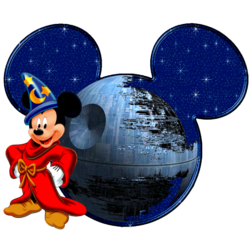Disney
 Disney's mascot, logo, and headquarters. | |
| Type | Humungous |
|---|---|
| Founded | 1923 |
| Founder(s) | Walt and Roy O. Disney |
| Headquarters | The Death Star in Disneyland |
| Key people | Bob Ijit (CEO) Mickey Mouse (mascot, President) Ron DeSantis (biggest fan) |
| Industry | Entertainment, world domination |
| Revenue | $0 (because Ron DeSantis took it all away) |
| Owner(s) | The Panderstone |
The Walt Disney Company, commonly referred to as The Mouse Empire, is a very, very, very, very wealthy corporation with more money than you will ever see in your lifetime founded by Walt Disney and his brother Roy O. Disney in 1923. The company is most commonly associated with talking rodents; big, black balls on your head; young royal females that every little girl wants to imitate; chain smoking, a slightly overrated amusement park; and being evil, though that last thing is becoming quite cliché.
History
1923–1927: the early years
Brothers Walt and Roy Disney began their careers as animators making flip-books in their uncle's garage, occasionally receiving a penny or two from passerby. In 1923, Walt created Alice's Wonderland, a twelve minute short film consisting of six minutes of unique footage. The plot circled around a young girl named Alice who dreams about living in a magical, cartoon world, creating a seemingly upbeat story. In the end, however, she falls off a cliff and dies. The film landed Walt and Roy a job producing animated comedies for Magaret J. Winkler, after which Walt created a new character, Oswald the Lucky Rabbit, a cute little bunny who never seemed to lose a game of blackjack. The cartoon, however, was so boring that everyone on Walt's staff left his animation company and began working for Winkler's husband.
1928–1954: the golden years

In 1928, after the failure of his earlier creation, Walt Disney gave birth to Disney's now-infamous mascot, Mickey Mouse, a half-naked rat that somehow appeals to children. Though Mickey Mouse was in a way Disney's first original character,[1] he was nowhere near the best,[2] similar to how Superman was the first superhero, yet The Green Hornet is by far the crème de la crème. Nevertheless, the creation of Mickey marked the beginning of Disney's success.
Soon after the creation of Mickey, Disney released their first full length feature film, Snow White and the Seven Dwarfs, in 1937. The film was an immediate hit, earning the company enough money to build its present-day headquarters. Its protagonist Snow White, a really attractive 14-year-old girl who loves singing, has delighted audiences around the world. It was not long before Disney began releasing more feature films. Pinocchio, Fantasia, Alice in Wonderland,Cinderella and various anti-Japanese propaganda films earned Disney a great reputation and some currency to boot.
1955–1971: pretty good years
In the 1950s Disney began to invest in the creation of its own independent nation, hoping to gain political dominance over the unimportant nations of Zimbabwe, Somalia, Moldova, and Eritrea, as well as any other country with inexpensive sweatshops. In 1955, the company unveiled Disneyland, dubbed "The Happiest Place on Earth with 'Land' in It's Name."[3] However, instead of becoming a prominent political power like Disney had intended, Disneyland was mistaken for a theme park, and thousands lined up to enjoy the various attractions, originally created for diplomatic negotiation. Its capital building, the Sleeping Beauty Castle, was soon modified to host dioramas and also served as a popular tourist trap, luring in unsuspecting children and brainwashing them into returning to the park year after year.
In 1966 Walt Disney died of complications relating to lung cancer. Though the general public, at first, could not decide whether this was a good or bad thing, it was eventually concluded that Walt's death was indeed a sad event, as Disney really seemed to go downhill after he passed away. Roy Disney followed his brother's suit five years later, marking the end of his life.
1972–1983: Relatively bad years
Throughout the '70s and '80s Disney released many instant classics such as Escape to Witch Mountain (1975), Take Down (1979), and The Black Hole (1979), whose names alone have become iconic. Sadly, the quality of Disney products began to decrease as the company got older, similar to how the radioactive carbon-14 isotope decays over time, halving its mass every 5,730±40 years. 1983 marked the launch of Disney Channel, essentially a poor man's Nickelodeon,[4] and possibly the most horrid thing Disney had ever created.[5] The network was originally a means of exposing children to documentaries and mediocre foreign films, but this would change in due time.
1984–1999: Relatively good years
In the mid-1980s Disney's incompetent management was sacked and given a new CEO named Michael Eisner. Under Eisner's leadership (and aided by Frank Wells, Roy E. Disney, and Jeffrey Katzenberg), Disney entered an era referred to by many as the "Disney Renaissance", where they produced such box office juggernauts as The Little Mermaid (1989), Beauty and the Beast (1991), The Lion King (1994), and Tarzan (1999) – each of which featured a triple-platinum soundtrack sung by Elton John and Phil Collins.
Since 2000: Decadence
By the turn of the millennium, however, Eisner's ego began to get the better of him. Believing 2D animation was a thing of the past, he ordered Disney to cease producing 2D features, instead switching to teenybopper media such as High School Musical, The Jonas Brothers, Hannah Montana, and Demi Lovato, as well as CGI talking animal pop culture-fests that poorly attempted to rip off Pixar. After becoming popular among teenage girls, Disney launched Radio Disney, which has become a popular form of torture at Guantanamo Bay.
Disney then proceeded to become evil after Roy E. Disney died in 2009 and Jeffrey Katzenberg left to found DreamWorks, whereupon the Walt Disney Company bought a comic book movieverse everyone and their brother wants to copy and ruined Star Wars. During these last decades, the company has preferred to release cheap nostalgia cash-grabs such as live-action adaptations that nobody has asked for, and has not produced even a single original film under the Disney brand ever since[6].
Controversies
Originality
There have been some complaints regarding the originality of many Disney films, considering that almost every good movie produced by Disney was based on a previous short story, fairy tale, novel, or play. However, recent documents have shown that the supposed "literary sources" that inspired these films were indeed written by Walt and Roy's ancestors, showing that they had true Disney origins. Through complex DNA analysis, the Brothers Grimm, the original authors of Snow White and Sleeping Beauty, were found to be Walt's great uncles, initially referred to as the Brothers Disney, and Peter Pan was found to be Walt's great-great grandfather, who had written the screenplay for the film Peter Pan as a sort of autobiography.
Subliminal messages
On several occasions conspiracy theorists and religious organizations have accused Disney of inserting subliminal messages into their feature films. The Lion King, for example, contains a scene in which Simba lies down on the edge of a cliff, throwing up a cloud of dust which supposedly spelled out the letters S-E-X. Parents were outraged, claiming that the letters were an acronym for Start Eating Xanax and that animators had slipped them in after being paid off by drug companies.
During one scene of The Little Mermaid, a bishop marrying Prince Edward and Ursula is supposedly seen sporting a bit of an erection. Catholic pro-life lobby group American Life League issued a boycott on Disney, claiming that showing a sexually aroused bishop in any movie, let alone one targeted at children, is a mockery of the Catholic Church and its practice of celibacy. The Little Mermaid also had rumors of a penis on its promotional artwork, supposedly drawn by a disgruntled artist.
Indecent exposure lawsuit
In August 2019 a class action lawsuit representing thousands of plaintiffs was filed against the Walt Disney Company in a federal court in Los Angeles for indecent exposure. The lawsuit seeks unspecified monetary damages and a cease and desist order against Donald Duck to stop flashing his genitals at young children. Mickey Mouse and Goofy have been named as co-conspirators in the lawsuit. Minnie Mouse has spoken out in support of the victims saying, "For too long, Donald Duck has shamelessly exposed himself to kids, coworkers, myself, and indeed the world. I am ashamed that I did not speak out sooner, and I applaud the brave victims for coming forward." Daisy Duck has not been reached for comment, and she is believed to have found political asylum in Cuba. The case is ongoing, and legal experts expect the case to reach the Supreme Court of the United States.
Ties with the CCP
In 2020, Disney decided to release a live-action adaptation for their 1998 Mulan, which was set in China. It seems that the production team was so focused on making this yet-another-nostalgia-cash-grab movie, they did not realize they were filming on concentration camps owned by the CCP. Several witnesses have reported that, after these news spread, Walt Disney's corpse was turning in his grave, and one could hear murmurs that went along the lines of "those damn commies have taken over my glorious empire!"
See also
- Walt Disney
- Disney Magic
- Ron DeSantis - Disney's biggest fan
- Rock-O-Jello - Disney's second-biggest fan
- Sherman Anti-Trust Act of 1890 - Fuck it, apparently
Notes
- ↑ Well, actually it wasn't; Oswald the Lucky Rabbit was.
- ↑ That title would probably have to go to Alex from Wizards of Waverly Place.
- ↑ Iceland and Greenland were hardly competition.
- ↑ As if Nickelodeon wasn't poor enough.
- ↑ With the exception of Euro Disney.
- ↑ With the exception of the 2023 film Wish, which is so generic and bland that it barely passes as an original film.
- Disney
- Companies
- Axis of Evil-Doers
- Mass Media
- Featured
- Disney Empire
- Film companies
- Film organizations
- Cartoons
- Animation
- Television in the United States
- Entertainment
- Companies of the United States
- Evil Organizations
- Bastion of Corporate Evil
- World domination
- People in Hell
- Why everyone hates Americans
- FA Arts and Entertainment
- FA Film
- FA Businesses and Organizations










